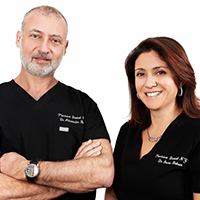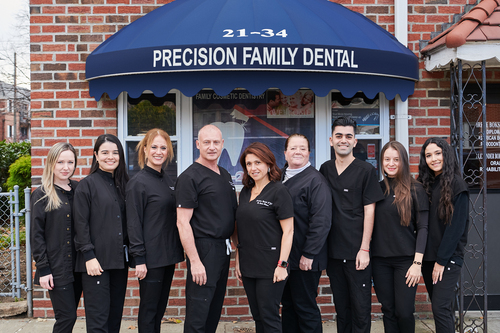Advanced Technology
Home » Advanced Technology
Dr. Alexander Bokser and Dr. Irene Bokser have advancedtraining in their respective fields and are able to provide the highest quality dental care,usingthe most advanced techniques and technology. This advanced training ensures lesspain and faster recovery time. The following provides a brief description of some of the technology used at our dental practice:
Digital x-rays can each be used to examine teeth for virtually any problem or disorder. They are programmed for magnification, colorization, and measurement to give the dentist the highest level of accuracy. Images can be magnified 1800x. This procedure increases the dentist’s diagnostic capability tremendously.
Digital radiography utilizes computerized equipment and software to capture x-ray images of your mouth and teeth. We do this by exposing a small sensor, or plate, that feeds the image into a computer.
Digital x-rays have several advantages over traditional film x-rays:
Medical conditions such as cancers and infections can be picked up using Digital Panorex. Digital full face imaging allows anatomically correct geometry, elimination of shadows and constant magnification. Used for a comprehensive diagnoses with less radiation for one photo of your whole lower face including TMJ joints.
Dental radiographs, or x-rays, are an important part of a thorough dental examination. A full set of x-rays is usually required for patients who are new to a dental practice or who need extensive treatment. Two to four follow-up or check-up x-rays called “bite-wings” are necessary every 6-12 months, depending on each individual patient’s needs. The most common questions concerning dental x-rays deal with: why they are needed, the amount of radiation exposure, and the safety during pregnancy.
Dental x-rays are important for many reasons. They can expose hidden dental decay; reveal a dental abscess, cyst or tumor; show impacted or extra teeth; and also help determine the condition of fillings, crowns, bridges, and root canals. Dental x-rays can also reveal bone loss from gum (periodontal) disease, locate tartar buildup, find foreign bodies within the gum or bone, and see if there is enough bone for the placement of dental implants. These are just some of the many reasons why dentists rely on dental x-rays.
Some people worry about their exposure to radiation during dental x-ray procedures. Our practice is very concerned about minimizing the amount of radiation a patient receives at our dental office. That’s why we use digital x-rays and cover patients with a lead apron during x-ray procedures. You will be happy to know that digital x-rays expose you to less than 1/100th the amount of typical annual background radiation for someone living in the New York City area. Dental x-rays are both safe and effective, and can be used during pregnancy.
Dental x-rays are an important tool in the diagnosis and treatment of dental problems. They do not, however, replace the need for a visual examination of the head, neck, TMJ and oral cavity. It is only with a combination of both the x-ray and the visual examination that the dentist can best treat his or her patients.
Schedule Your Appointment
Anintraoralcamerais acamerawhich is designed to be used in the mouth for the purpose of taking video or still photography. These cameras are most commonly used in dental offices, with several firms specializing in producingintraoralcameras and accessories.One of the primary uses for anintraoralcamerais in patient education. Dentists often find it helpful to be able to show patients exactly what is going on inside their mouths, and to highlight areas where medical attention may be needed. Patients are also less likely to defer or refuse procedures when they can clearly see the area at issue, as some people are suspicious of recommendations for dental procedures, due to concerns about cost, potential pain, or the fears about members of the dental profession.
In addition to being used in patient education, such cameras can also be used to take clear visual records for patient files, and to generate material which can be used in consultations and discussions with other dental providers. For example, a general dentist might use anintraoralcamerato take images of a tooth or area of the jaw which requires oral surgery so that a maxillofacial surgeon can examine the information before he or she meets the patient to get an idea of the kind of surgery which might be required.
Images taken by anintraoralcameracan also be reviewed later, which can be useful for a dentist who feels a nagging suspicion that something is not quite right in the mouth of a patient. The intraoralcameracan also be used to document procedures for legal and educational reasons, and to create projections of a patient’s mouth which can be used in medical schools for the purpose of educating future dentists about various issues which pertain to oral health.
Theintraoralcameras designed for use in dental facilities come with disposable probes or probe covers to ensure that germs are not passed between patients, and they may come with a variety of options which enhance the functionality of thecamera. Versions designed for home use are usually much more basic, but they can still be useful for people who want to see the inside of the mouth. Using acameraat home, someone can identify an issue which requires a dentist’s attention, keep an eye on a recovering surgical site, or teach children about the importance of oral hygiene.
PROPHY-JET is an air polishing prophylaxis system which uses air, water, and either sodium bicarbonate powder as a slurry to remove extrinsic stain, dental plaque and soft debris while simultaneously polishing tooth surfaces.
A loupe (pronounced loop), is a type of magnification device used to see things one is looking at more closely. In this respect, they are simply a form of a modified microscope, allowing the dentist to be able to better apply the phenomenon of microscopy to his or her trade.
Our dentists use binocular loupes with a self-contained light source to better scrutinize the entities within our patients’ mouths in order to make a better diagnosis. For example, it may allow for more precise determination of how far a crack proceeds along the surface of a tooth. Loupes are also used in order to perform on a more precise level; while dentists drill teeth on a millimeter scale, magnification can enlarge the dentists’ view of the teeth, making it easier to inspect teeth for decay and/or see things that ordinarily would not be seen without magnification.
★★★★★We recently moved to Astoria so it was time to find a new dentist. Dr. Alexander Bosker was very professional and displayed he is great at his job. The entire staff was pleasant. I would highly recommend Precision Dental to anyone.
GregThis page was modified on by Dr. Alexander Bokser, DDS (Dentist) of Precision Dental NYC

Dr. Alexander Bokser is a dentist in Astoria, NY and Bayside, NY. He received his degree from New York University College of Dentistry, licensed by the New York State Board of Regents and the North East Regional Board of Dental Examiners.
He is currently teaching dentistry at Albert Einstein School of Medicine. Dr. Bokser has received numerous awards in dentistry and community service. He is a member of the American Dental Association, Academy of General Dentistry, and North Queens Dental Study Club.
More About Dr. Bokser



